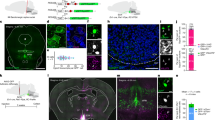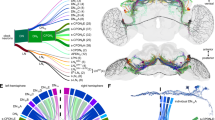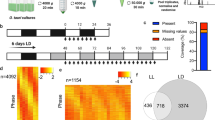Abstract
The circadian pupal eclosion rhythm was studied in 12 strains of Drosophila subobscura originating from two regions: Scandinavia (56–63°N), and the Canary Islands (28°N). In most parameters of the rhythm, ample variability was found both within and between the regions. Among the strains the phase of the eclosion median in an entraining diel light-dark cycle varied by 8.1 h, and the period of the free-running rhythm (τ) by 2.2 h. In the comparison between the two regions, the Scandinavian entrained rhythm had on average a 2.8 h earlier phase, τ was 0.9 h shorter, and the amplitude of the rhythm was lower. Of the rhythm parameters, early phase was correlated with short τ (r = 0.76), and the amplitude of the entrained rhythm was correlated with the amplitude of the free-running rhythm (r = 0.98). In addition to the geographical variation, a putative arhythmic recessive autosomal mutant was found to segregate in one Scandinavian strain. The lack of photoperiodic adult diapause was confirmed in D. subobscura. The results show that the circadian eclosion rhythm in a non-photoperiodic species can vary latitudinally in a fashion similar to that of photoperiodic species.
Similar content being viewed by others
Article PDF
References
Afonso, J M, Voltz, A, Hernández, M, Ruttkay, H, González, M, Larruga, J M, Cabrera, V M, and Sperlich, D. 1990. Mitochondrial DNA variation and genetic structure in Old-World populations of Drosophila subobscura. Mol Biol Evol, 7, 123–142.
Begon, M. 1976. Temporal variations in the reproductive condition of Drosophila obscura Fallén and D. subobscura Collin. Oecologia, Berl, 23, 31–47.
Brncic, D, and Budnic, N. 1984. Experiments on sexual isolation between Chilean and European strains of Drosophila subobscura. Experientia, 40, 1014–1016.
Budnik, M, Cifuentes, L, and Brncic, D. 1991. Quantitative analysis of genetic differentiation among European and Chilean strains of Drosophila subobscura. Heredity, 67, 29–33.
Cabrera, V M, González, A M, Hernández, M, Larruga, J M, and Martell, M. 1985. Microgeographic and temporal genetic differentiation in natural populations of Drosophila subobscura. Genetics, 110, 247–256.
Clayton, D L, and Paietta, J V. 1972. Selection for circadian eclosion time in Drosophila melanogaster. Science, 178, 994–995.
Engelmann, W, and Mack, J. 1979. Different oscillators control the circadian rhythms of eclosion and activity in Drosophila. J Compl Physiol, 33, 583–608.
Gosteli, M. 1991. Differential flight activity among karyotypes: daily and weather-induced changes in chromosomal inversion polymorphism in natural populations of Drosophila subobscura. Genetica, 84, 129–136.
Hall, J C. 1990. Genetics of circadian rhythms. Annu Rev Genet, 24, 659–697.
Ikeda, H, and Saito, M. 1983. Effects of circadian eclosion rhythm and temperature on estimating the relative rate of development in Drosophila mercarotum. Zoological Magazine, 92, 174–179.
Konopka, R J, and Benzer, S. 1971. Clock mutants of Drosophila melanogaster. Proc Natl Acad Sci USA, 68, 2112–2116.
Krimbas, C B, and Loukas, M. 1980. The inversion polymorphism of Drosophila subobscura. Evol Biol, 12, 163–234.
Krimbas, C B, and Powell, J R. 1992. Inversion Polymorphism of Drosophila. CRC Press, Boca Raton, Florida.
Kyriacou, C B, Oldroyd, M, Wood, J, Sharp, M, and Hill, M. 1990. Clock mutations alter developmental timing in Drosophila. Heredity, 64, 395–401.
Lankinen, P. 1985. Genetic variation of circadian eclosion rhythm, and its relation to photoperiodism in Drosophila littoralis. Doctoral dissertation, University of Oulu.
Lankinen, P. 1986a. Geographical variation in circadian eclosion rhythm and photoperiodic adult diapause in Drosophila littoralis. J Comp Physiol A, 159, 123–142.
Lankinen, P. 1986b. Genetic correlation between circadian eclosion rhythm and photoperiodic diapause in Drosophila littoralis. J Biol Rhythms, 1, 101–118.
Lankinen, P. 1987. Latitudinal variation of time measurement in Drosophila phalerata. Proc 10th Eur Drosoph Res Conf, Barcelona, 157.
Lankinen, P. 1993a. Independent inheritance of photoperiodic diapause and circadian eclosion rhythm in long term crosses between geographically variable strains of Drosophila littoralis. J Biol Rhythms, in press.
Lankinen, P. 1993b. Characterization of linne, a new autosomal eclosion rhythm mutant in Drosophila subobscura. Behavior Genetics, 23, in press.
Lankinen, P, and Lumme, J. 1982. An improved apparatus for recording the eclosion rhythm in Drosophila. Dros Inf Serv, 58, 161, 163.
Lankinen, P, and Riihimaa, A J. 1992. Weak circadian eclosion rhythmicity in Chymomyza costata (Diptera: Drosophilidae), and its independence of diapause type. J Insect Physiol, 38, 803–811.
Latorre, A, Hernández, C, Martínez, D, Castro, J A, Ramón, M, and Moya, A. 1992. Population structure and mitochondrial DNA gene flow in Old World populations of Drosophila subobscura. Heredity, 68, 15–24.
Pfriem, P. 1983. Latitudinal variation in wing size in Drosophila subobscura and its dependence on polygenes of chromosome O. Genetica, 61, 221–232.
Pfriem, P, and Sperlich, D. 1982. Wild chromosomes O of Drosophila subobscura from different geographic regions have different effects on viability. Genetica, 60, 49–59.
Pittendrigh, C S. 1966. The circadian oscillation in Drosophila pseudoobscura pupae: a model for the photoperiodic clock. Z Pflanzenphysiol Bd, 54, 275–307.
Pittendrigh, C S. 1967. Circadian systems, I. The driving oscillation and its assay in Drosophila pseudoobscura. Proc Natl Acad Sci USA, 58, 1762–1767.
Pittendrigh, C S. 1981. Circadian organization and the photoperiodic phenomena. In: Follet, B. K. and Follet, D. E. (eds) Biological Clocks in Seasonal Reproductive Cycles, Wright, Bristol, pp. 1–35.
Pittendrigh, C S, and Takamura, T. 1987. Temperature dependence and evolutionary adjustment of critical night length in insect photoperiodism. Proc Natl Acad Sci USA, 84, 7169–7173.
Pittendrigh, C S, and Takamura, T. 1989. Latitudinal clines in the properties of a circadian pacemaker. J Biol Rhythms, 4, 217–235.
Prevosti, A. 1955. Geographical variability in quantitative traits in populations of Drosophila subobscura. Cold Spring Harb Symp, 20, 294–299.
Prevosti, A. 1968. Efecto de la Cordillera pirenaica sobre la distribución geographica de las ordenaciones cromosómicas de Drosophila subobscura. Pirineos, 79–80, 221–228.
Prevosti, A, Ribo, G, Serra, L, Aguade, M, Balaña, J, Monclus, M, and Mestres, F. 1988. Colonization of America by Drosophila subobscura: experiment in natural populations that supports the adaptive role of chromosomal-inversion polymorphism. Proc Natl Acad Sci USA, 85, 5597–5600.
Saunders, D S, Henrich, V C, and Gilbert, L I. 1989. Induction of diapause in Drosophila melanogaster: photoperiodic regulation and the impact of arrhythmic clock mutations on time measurement. Proc Natl Acad Sci USA, 86, 3748–3752.
Saura, A, Johansson, B, Eriksson, E, and Kohonen-Corish, M. 1990. Genetic load in northern populations of Drosophila subobscura. Hereditas, 112, 283–287.
Saura, A, Lokki, J, Lankinen, P, and Järvinen, O. 1973. Entsyymipolymorfismit populaatiogenetiikassa ja evoluutiotutkimuksessa. Luonnontutkija, 4–5, 101–111.
Smith, P H. 1987. Naturally occurring arrhythmicity in eclosion and activity in Lucilia cuprina. Physiol Entomol, 12, 99–107.
Walter, T. 1990. Über den Nachweis von Drosophila-Arten während des Winters im seweizerischen Mittelland. Mitteilungen der Schweizerischen Entomologischen Gesellschaft, 63, 115–120.
Winfree, A T. 1980. The Geometry of Biological Time Bio-mathematics, Vol. 8, Springer-Verlag, New York, 530 pp.
Author information
Authors and Affiliations
Rights and permissions
About this article
Cite this article
Lankinen, P. North–south differences in circadian eclosion rhythm in European populations of Drosophila subobscura. Heredity 71, 210–218 (1993). https://doi.org/10.1038/hdy.1993.126
Received:
Issue date:
DOI: https://doi.org/10.1038/hdy.1993.126
Keywords
This article is cited by
-
Integration of photoperiodic and temperature cues by the circadian clock to regulate insect seasonal adaptations
Journal of Comparative Physiology A (2023)
-
Life-history traits of Drosophila melanogaster populations exhibiting early and late eclosion chronotypes
BMC Evolutionary Biology (2016)
-
Gene expression clines reveal local adaptation and associated trade-offs at a continental scale
Scientific Reports (2016)
-
Genetic basis of incidence and period length of circadian rhythm for locomotor activity in populations of a seed beetle
Heredity (2010)
-
Genetic variation in locomotor activity rhythm among populations ofLeptopilina heterotoma (Hymenoptera: Eucoilidae), a larval parasitoid ofDrosophila species
Behavior Genetics (1995)



